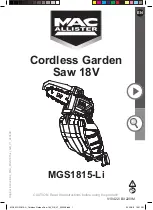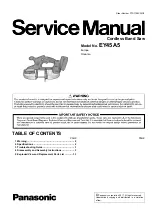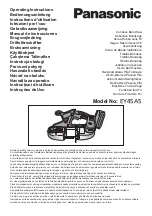
EN
26
Sawing
1. Start the tool before applying it against
the workpiece.
2. Place the pad against the surface of the
workpiece and move the blade through
the workpiece with a steady pressure.
3. Release the power switch immediatly if the
blade jams or fastens. Widen the cut with
a suitable tool and pull out the blade.
4. Switch off the tool by releasing the power
switch after finishing the work.
Plunge sawing
Plunge sawing must only be carried out in soft
materials such as wood and plasterboards, etc.
It requires some practice, and can only be done
with short blades.
FIG. 4
– Apply the edge of the pad against
the workpiece and switch on the
tool. Note that the edge of the pad
must rest against the surface of the
workpiece.
– Carefully press the saw blade against
the workpiece so that it goes into the
material.
– Increase the angle until the tool is at
right angles to the workpiece and
continue sawing along the saw line.
– Switch off the tool and pull the blade
out from the workpiece.
– It is easier to do plunge sawing if the
saw blade is turned 180°.
Flush sawing
With suitable saw blades it is possible to saw
off extruding sections flush with adjacent
surfaces.
1. Place the saw blade with the side against
the adjacent surface and press so that the
edge of pad rests against the adjacent
surface.
2. Start the tool and saw by maintaining the
pressure sideways.
NOTE:
The saw blade sticks out behind the
workpiece – risk of kickback.
VARIABLE STROKE RATE SETTING
Tap the power switch for low stroke rate.
Press harder to increase the stroke rate.
PIVOTING SUSPENSION PAD
The suspension pad pivots to follow the surface
of the workpiece.
MAINTENANCE
WARNING!
• Always pull out the plug before working
on the reciprocating saw.
• Keep tools sharp and clean for better and
safer work.
• If a fault or malfunction occurs, have the
power tool checked by an authorised
service centre.
• Never open the power tool.
CLEANING
• Clean the ventilation openings on the
power tool at regular intervals.
• Clean the power tool with a damp cloth.
Wipe dry afterwards.
NOTE:
Many detergents contain chemicals that can
corrode the plastic parts on the power tool.
Never use petrol, turps, thinner or other
similar products.
STORAGE
• When the power tool is not in use store it
in a dry and safe place with a temperature
of no more than 40°C and out of reach of
unauthorised persons.
• Do not expose power tools to moisture.
Summary of Contents for 017682
Page 4: ...1 2 3 2 1 6 7 1 2 3 4 5 4 ...
Page 5: ...3 5 2 4 ...
















































